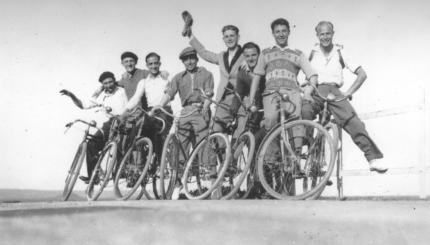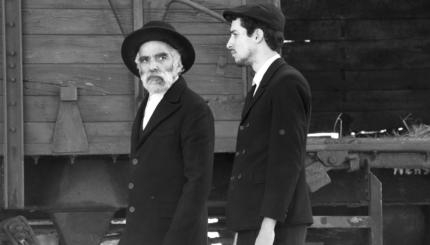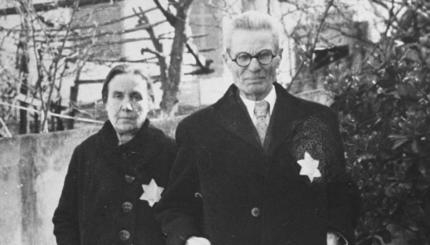Buildings sway and undulate, faces appear pensive and distorted, and landscapes express all the angst and psychological tumult of a young emigre’s life. In the paintings of Chaim Soutine (paintred below by Amedeo Modigliani), the classic subjects of art history meet a new, vibrantly charged aesthetic that combined the artist’s Jewish sensibility with the energy of the avant-garde. Compared to artists as different as Rembrandt, Van Gogh, and Jackson Pollack, Soutine’s work bridged the divide between the Cubism and Fauvism that influenced him and the abstract expressionism that was to come after him.
The Early Years
Born in 1893 outside of Minsk, Belarus as the 10th child in an Orthodox Jewish family, Soutine rebelled against his tradition during adolescence and enrolled in the art school in Vilnius. At the age of 20, after showing much promise in his early work, he moved to Paris with two of his art school friends, Pinchus Kremegne and Michel Kikoine. There he studied at the Ecole des Beaux Arts under Fernand Cormon and took a room in the notorious artists flat, La Ruche, in Montparnasse.
In his 20s, Soutine live the life of a Parisian bohemian, spending late nights drinking in bars with other artists and his afternoons recovering and working madly in his studio. Soutine relished the freedom of his new French life and made friends with several of the notable artists of the time. Yet his closest companions were always other Jews. Soutine and Amadeo Modigliani, a émigré from Italy, shared not only a flat, but stylistic innovations, models, and the same dealer.
During this early period, Soutine was known for his still lifes. Freed from the restrictions of salon-style classicism, in which artists were expected to paint historical tableaux, Soutine and his peers were experimenting with shape and texture and pursuing new visions of everyday objects. Still Life with Fish (1921) shows how Soutine was playing with the application of paint, allowing it to thicken into an almost sculptural expression.

Help us keep Jewish knowledge accessible to millions of people around the world.
Your donation to My Jewish Learning fuels endless journeys of Jewish discovery. With your help, My Jewish Learning can continue to provide nonstop opportunities for learning, connection and growth.
Raw and Primitive
Carcass of Beef
Minneapolis Institute of Arts
(c) 2006 Artists Rights Society
New York/ADAGP, Paris
Many of his still lifes reject the bourgeois taste for traditionally beautiful objects; he became fixated on fish and meat carcasses, the visceral intensity of putrefying flesh. His paintings (and his personality) were raw and primitive. Indeed even his painting method had a bit of savagery. At one point while painting Carcass of Beef (1924), his neighbors called the police because of the stench of the decaying animal in his studio. When police arrived, they received a lecture from an irate Soutine, who admonished them about disturbing him as he did his greatest work.
Soutine’s temperament and capricious character, certainly exacerbated by the company he kept, was always sabotaging his work, which he seldom showed publicly. In furious rages he would destroy his paintings, lash out at his friends and console himself with thoughts of suicide–which he once attempted (he was saved by his friend Kremegne). When his best friend Modigliani died prematurely in 1920, Soutine was gravely affected. Many critics attributed aspects of his temperament to his Jewish background and his experience with poverty and persecution in the .
Soutine’s landscapes communicate his depression and anguish, with their twisted, sinewy trees, distorted houses and tempestuous expanses. From 1918 to 1923, Soutine traveled frequently to the south of France and remained for a couple of years in Ceret, a small town in the Pyrenees. His apocalyptic visions of the town (seen in Houses of Ceret, 1920), show a row of houses leaning away from the wind and black sky as if in the clutch of terror. The surrounding greenery is twisted and thick with paint; the viewer senses Soutine’s pervading sorrow and anxiety. The Road at Cagnes (1922-23) is a classic of this period: its stark navy and chartreuse coloring dramatically contours a picturesque road that has become foreboding and tormented under Soutine’s brush.
Fame Arrives
When Soutine returned to Paris, he shifted his focus to portraits. He was particularly fascinated by maids and valets, and one of his best known portraits is the Little Pastry Cook (1921), which takes a pitying glance at a comical, diminutive chef whose body’s wavy elongation had become a signature of Soutine’s style.
Le Petit Patissier
Portland Art Museum
(c) 2006 Artists Rights Society
New York/ADAGP, Paris
An impromptu studio visit in 1923 from Albert Barnes, the wealthy American collector, was the windfall of fortune that Soutine had been waiting for. Barnes foresaw Soutine’s work as the next movement in European painting and bought 52 of his paintings in one trip. The Barnes Collection, located outside of Philadelphia, now has the largest collection of Soutines in the world, and it was Barnes who helped bring world renown to the artist. He introduced Soutine to French taste-maker Madeleine Castaing, who became the artist’s patroness. She and her husband, Marcellin, bought most of his works and made their residence near Chartres a Soutine atelier. From their home, Soutine was afforded the luxury to paint anything he wanted, free from the pressures of making a living and living in cramped Parisian quarters.
It was during this period in the late 1920s and 30s that Soutine’s reputation advanced. His initial naïve outsider primitivism had morphed into critically acclaimed work hailed as the inheritance of the European painting tradition. His career trajectory mirrored his life’s arc. Soutine had transformed from a shtetl boy into an assimilated French painter.
A Tragic End
In 1937, just before the Nazis took over France in the Vichy regime, Soutine’s works were exhibited in the show of Independent Art held in Paris. Here he was at last acclaimed in the press and public opinion as a great painter. But shortly after the show ended, Soutine was forced to flee Paris and stay wherever he could to avoid arrest by the Gestapo. He often had to sleep outdoors in the forests and farms surrounding Paris. At that time he was romantically involved with a woman he called Mademoiselle Garde, who accompanied him in his fugitive pursuit. She was tragically captured and interned in a camp in the Pyrenees; he was never to see her again.
It was during this stressful period of persecution that a life-long health problem that had kept him out of military service re-emerged. With an increasingly painful stomach ulcer, Soutine sought medical help from a doctor who insisted that he immediately get an ambulance to Paris. Unfortunately the ambulance was delayed and on August 9, 1943, Chaim Soutine died after emergency surgery. He was buried in Montparnasse cemetery in Paris. His funeral was attended by Pablo Picasso, the playwright Jean Cocteau, the poet Max Jacob, and other cultural luminaries of the time.
After his death, Soutine’s reputation as one of the foremost Expressionist painters was established, and his works were bought up by top collectors. They now sell for prices between $180,000 and $2,500,000. Today Soutine’s emotionally-tinged landscapes and misshapen portraits adorn the walls of several prominent museums in the US, Europe, and Israel. He has had career retrospective exhibitions at both the Museum of Modern Art in New York and the Jewish Museum in New York. Next to Marc Chagall, Soutine is considered one of the 20th century’s premier Jewish artists, though none of his work explicitly addressed Jewish themes. But in the wake of his tragic death, Soutine became a symbol of the Holocaust. Despite the fact that he died of natural causes and was never placed in a detention camp, his story of emigration, assimilation and destruction outlines the tragedy of European Jewish life.





